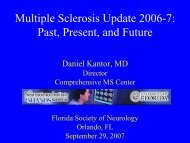Hubert H. Fernandez, MD - Florida Society of Neurology
Hubert H. Fernandez, MD - Florida Society of Neurology
Hubert H. Fernandez, MD - Florida Society of Neurology
You also want an ePaper? Increase the reach of your titles
YUMPU automatically turns print PDFs into web optimized ePapers that Google loves.
Common Indications forBotox• Dystonia (ST, blepharospams, , focal andsegmental)• Hemi-facial spasms• Spasticity• Headache• Wrinkles• Drooling• Gait freezing
Dystonia“….is a neurologic syndrome characterized byinvoluntary, sustained, patterned, and <strong>of</strong>tenrepetitive muscle contractions <strong>of</strong> opposingmuscles causing twisting movements orabnormal postures. Partly because <strong>of</strong> its richexpression and a variable course, dystoniais frequently not recognized ormisdiagnosed” Fahn 1984.
Main features <strong>of</strong> dystonia• relatively long duration (unlikechorea or myoclonus)• simultaneous contractions <strong>of</strong> agonistand antagonist muscles• results in twisting <strong>of</strong> a body part• same muscle groups are generallyinvolved
Other Features• Primary dystonia almost always begins by affecting a singlepart <strong>of</strong> the body (focal dystonia); most <strong>of</strong>ten the spread isto contiguous body parts• The younger the age at onset, the more likely for dystoniato spread• Action dystonia: dystonic movement aggravated duringvoluntary movements• Task specific dystonia: abnormal movement appear duringspecial action• Overflow: as dystonia progresses, non-specific voluntaryaction can bring out dystonia, also actions in other parts <strong>of</strong>the body can induce dystonic movements <strong>of</strong> the primarilyaffected body part• Worsen with fatigue, stress; suppressed with sleep,hypnosis, relaxation• Sensory tricks (geste(antagoniste)• Pain is not very common except in cervical dystonia• Can present with tremor (dystonic tremor) or myoclonus(dystonia-myoclonus)
Overflow Dystonia
Task Specific Dystonia
Sensory Trick
Classification• By Age at Onset– Early onset (26 years)• By Distribution– Focal - single body region (e.g., writer’s s cramp, torticollis, blepharospasm)– Segmental - contiguous body regions (e.g., face+jaw [Meige’s], neck+arm)– Multifocal - non-contiguous body regions (e.g., arm+leg, bleph+writer’s cramp)– Generalized - both legs + at least one other body region (one or both arms)• By Cause– Primary (idiopathic) - dystonia is only sign in the absence <strong>of</strong> identifiableexogenous cause or other inherited or degenerative disease– Secondary (symptomatic)• Dystonia-plus(accompanied by parkinsonism or myoclonus)• Heredodegenerative dystonia (X-linked, autosomal dominant or recessive)• Acquired/exogenous (drugs, trauma, stroke)• Parkinsonian syndromes (PD, CBGD, PSP)
Focal Dystonias• Cervical dystonia (CD)or spasmodic torticollis• Blepharospasm• Laryngeal dystoniaor spasmodic dysphonia (SD)• Limb dystonia(writer’s s or musician’s s cramp, etc.)
Cervical Dystonia:idiopathic
Cervical dystonia: tardive
Cervical Dystonia: tardive
Blepharospasms
Apraxia <strong>of</strong> eyelid opening
Laryngeal Dystonia:adductor
Laryngeal Dystonia:abductor
Focal Limb Dystonia
Hemi-dystonia
Generalized Dystonia
Secondary Dystonia:Lubag
Secondary Dystonia:perinatal injury
Secondary Dystonia: PostTraumatic
Dystonia in CBGD
Dystonia in PD
Dystonia in PSP
Therapy• Pharmacotherapy– CNS active drugs• Anticholinergics• GABAergics (benzodiazepines, bacl<strong>of</strong>en, tizanidine)• Dopaminergics (DA agonists, DA antagonists, DA depletors)• Other (carbamazepine, alcohol, lithium, cannabinoids)– Local injections (Botulinum toxin)• Physical and supportive therapy– PT and orthopedic devices (bracing)– Repetitive transcranial magnetic stimulation– Patient and caregiver education and support• Surgical therapy– Peripheral denervation– Central• Ablative procedures (thalamotomy, pallidotomy)• DBS
Botox for the face:Blepharospasmsxxx xx x x xxx x x
Botox for headache• Frontalis• Temporalis• Insertion <strong>of</strong> the SCM• Occipitalis• Upper Trapezius
Botox for HemifacialSpasmsxxxxxx
Jaw dystonia• Jaw closing dystonia– Masseter– Temporalis• Jaw opening dystonia– Lateral pterygoids– Digastric
Cervical Dystonia: : Whichmuscles to inject?• Torticollis (chindeviation)• Laterocollis (tilt)• Anterocollis (neckflexion)• Retrocollis (neckextension)• Shoulder elevation• Head tremor
Torticollis• Contralateral SCM• Ipsilateral spleniuscapitis• Ipsilateralsemispinalis capitis
Laterocollis• Ipsilateral scalenes• Ipsilateral levatorscapulae• Ipsilateral spleniuscapitis• Ipsilateral SCM
Shoulder elevation• Ipsilateral levatorscapulae• Ipsilateral uppertrapezius
Anterocollis• Bilateral SCM• Bilateral anteriorscalene• Bilateralsubmentalis
Retrocollis• Bilateral spleniuscapitis• Bilateral trapezius• Bilateralsemispinalis capitis
Head tremor• Main vscompensatorymuscles• 3 to 4: 1 dosingratio
Structures to avoid• Brachial plexus• Carotid sheath• Greater occipital nerve• Larynx and trachea• Pharynx andesophagus• Thyroid gland• Pleura and apex <strong>of</strong> thelung
Post-injectionexpectations• 70% get about 60-80% improvement• 3-44 months duration• Side effects– Dysphagia– Pain– Dry mouth– Fatigue• Secondary non-reponsiveness
Let’s s do some exercises!
Example 1
Example 2
Example 3
DosingIncrease• Low weight• Small muscle bulk• Mild disease• High probability <strong>of</strong>weakness• Too muchweakness fromprevious injectionDecrease• Heavy weight• Large muscle bulk• Severe disease• Low concern forweakness
Materials Needed• 30G x ½” needle• 27G x 1¼” 1needle• 21G x 2” 2 needle• 1 cc syringe• Lidocaine 4% topical cream• Preservative free normal saline
Thank you!




